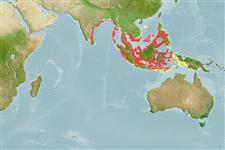Common names from other countries
>
Ovalentaria/misc (Various families in series Ovalentaria) >
Opistognathidae (Jawfishes)
Etymology: Opistognathus: Greek, opisthe = behind + Greek, gnathos = jaw (Ref. 45335); to the very elongate upper jaw of the type species of the genus, Opistognathus nigromarginatus (Ref. 128653); cyanospilotus: Nmae from Greek 'kyaneos' meaning dark blue and 'spilotos' for spotted, in reference to the characteristic blue markings on the head..
Environment: milieu / climate zone / depth range / distribution range
Sinh thái học
Biển; Mức độ sâu 12 - 30 m (Ref. 81517). Tropical
Eastern Indian Ocean: Thailand (Andman Sea) and Indonesia (Sumatra).
Bộ gần gũi / Khối lượng (Trọng lượng) / Age
Maturity: Lm ? range ? - ? cm
Max length : 13.0 cm TL con đực/không giới tính; (Ref. 81517); 11.6 cm SL (female)
Short description
Khóa để định loại | Hình thái học | Sinh trắc học
Các tia vây lưng cứng (tổng cộng) : 11; Các vây lưng mềm (tổng cộng) : 15 - 16; Tia cứng vây hậu môn: 3; Tia mềm vây hậu môn: 15; Động vật có xương sống: 29. This species is distinguished by the following characters: moderately elongate supramaxilla and mostly rigid maxilla with only a slight flexible lamina posteriorly extending about 0.9-1.2 eye diameters behind posterior margin of orbit; D XI,15-16; A III,15; vertebrae 10+19; gill rakers 11-12+21-23; infraorbitals are moderately robust, the second and third with large sensory canal openings, third infraorbital with large suborbital shelf; lateral-line ends below verticals between sixth to eighth segmented dorsal-fin rays; caudal vertebrae 19. Colouration: upper jaw's inner lining and adjacent membranes with a black blotch; when alive, the opercle, cheeks and upper jaw with prominent blue spots or blotches; no dark blotches on body and dorsal fin (Ref. 81517, 128653).
Found in sand/rubble bottoms among reefs in 12-30 m (Ref 90102).
Life cycle and mating behavior
Maturities | Sự tái sinh sản | Spawnings | Egg(s) | Fecundities | Ấu trùng
Smith-Vaniz, W.F., 2023. Review of Indo-West Pacific jawfishes (Opistognathus: Opistognathidae), with descriptions of 18 new species. Zootaxa 5252(1):1-180. (Ref. 128653)
IUCN Red List Status (Ref. 130435)
CITES (Ref. 128078)
Not Evaluated
Threat to humans
Harmless
Human uses
Các công cụ
Special reports
Download XML
Các nguồn internet
Estimates based on models
Preferred temperature (Ref.
115969): 28.2 - 29.2, mean 28.8 (based on 142 cells).
Phylogenetic diversity index (Ref.
82804): PD
50 = 0.5000 [Uniqueness, from 0.5 = low to 2.0 = high].
Bayesian length-weight: a=0.00389 (0.00180 - 0.00842), b=3.12 (2.94 - 3.30), in cm Total Length, based on all LWR estimates for this body shape (Ref.
93245).
Mức dinh dưỡng (Ref.
69278): 3.5 ±0.6 se; based on size and trophs of closest relatives
Fishing Vulnerability (Ref.
59153): Low vulnerability (10 of 100).
